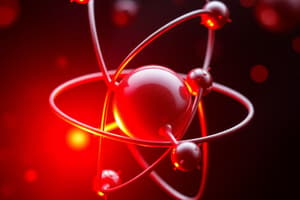Podcast
Questions and Answers
What type of bonding holds the atoms together in a crystal structure?
What type of bonding holds the atoms together in a crystal structure?
- Ionic bonding
- Metallic bonding
- Hydrogen bonding
- Covalent bonding (correct)
Why are pure silicon and germanium poor conductors of electricity?
Why are pure silicon and germanium poor conductors of electricity?
- Due to the presence of free electrons
- Due to the presence of positive charge holes
- Due to covalent bonding holding valence electrons tightly (correct)
- Due to the presence of metallic bonding
What type of semiconductor has impurities added by a process called doping?
What type of semiconductor has impurities added by a process called doping?
- Intrinsic semiconductor
- Metallic semiconductor
- Extrinsic semiconductor (correct)
- Molecular semiconductor
What happens when intrinsic silicon gains sufficient heat?
What happens when intrinsic silicon gains sufficient heat?
In extrinsic semiconductors, what effect does the doping process have on conductivity?
In extrinsic semiconductors, what effect does the doping process have on conductivity?
What makes semiconductive materials conduct in terms of electrons and holes?
What makes semiconductive materials conduct in terms of electrons and holes?
What is the primary function of valence electrons in an atom?
What is the primary function of valence electrons in an atom?
What do you call an atom with four valence electrons?
What do you call an atom with four valence electrons?
What is the characteristic of a balanced atom?
What is the characteristic of a balanced atom?
What happens when the negative charge of electrons cancels the positive charge of protons in an atom?
What happens when the negative charge of electrons cancels the positive charge of protons in an atom?
What type of material has conduction bands and valence bands that are not separated?
What type of material has conduction bands and valence bands that are not separated?
How many valence electrons does Carbon have?
How many valence electrons does Carbon have?
What happens to some valence electrons in an intrinsic silicon crystal at room temperature?
What happens to some valence electrons in an intrinsic silicon crystal at room temperature?
What is the movement of holes in a semiconductor material called?
What is the movement of holes in a semiconductor material called?
What is the primary characteristic of an insulator?
What is the primary characteristic of an insulator?
What happens when a conduction-band electron loses energy and falls back into a hole in the valence band?
What happens when a conduction-band electron loses energy and falls back into a hole in the valence band?
What occurs in an insulator when the temperature increases?
What occurs in an insulator when the temperature increases?
Why are thermally generated free electrons in the conduction band attracted toward the positive end when a voltage is applied?
Why are thermally generated free electrons in the conduction band attracted toward the positive end when a voltage is applied?
What is left in the valence band when a valence electron jumps into the conduction band?
What is left in the valence band when a valence electron jumps into the conduction band?
What is unique about the bonding in a silicon crystal?
What is unique about the bonding in a silicon crystal?
What is the primary difference between an insulator and a semiconductor?
What is the primary difference between an insulator and a semiconductor?
In the valence band, how do electrons move into nearby holes?
In the valence band, how do electrons move into nearby holes?
What is the characteristic of an intrinsic semiconductor material?
What is the characteristic of an intrinsic semiconductor material?
What is the purpose of covalent bonding in a silicon crystal?
What is the purpose of covalent bonding in a silicon crystal?
According to the Bohr model, what is the electric charge of an electron?
According to the Bohr model, what is the electric charge of an electron?
What is the atomic number of an element if its atom contains 20 protons?
What is the atomic number of an element if its atom contains 20 protons?
How many electrons can the outermost shell of an atom hold, according to the information given?
How many electrons can the outermost shell of an atom hold, according to the information given?
Which particles in Bohr's model determine the element's chemical properties?
Which particles in Bohr's model determine the element's chemical properties?
Considering the given information, which property makes an atom stable?
Considering the given information, which property makes an atom stable?
What is the electric charge of a proton?
What is the electric charge of a proton?




